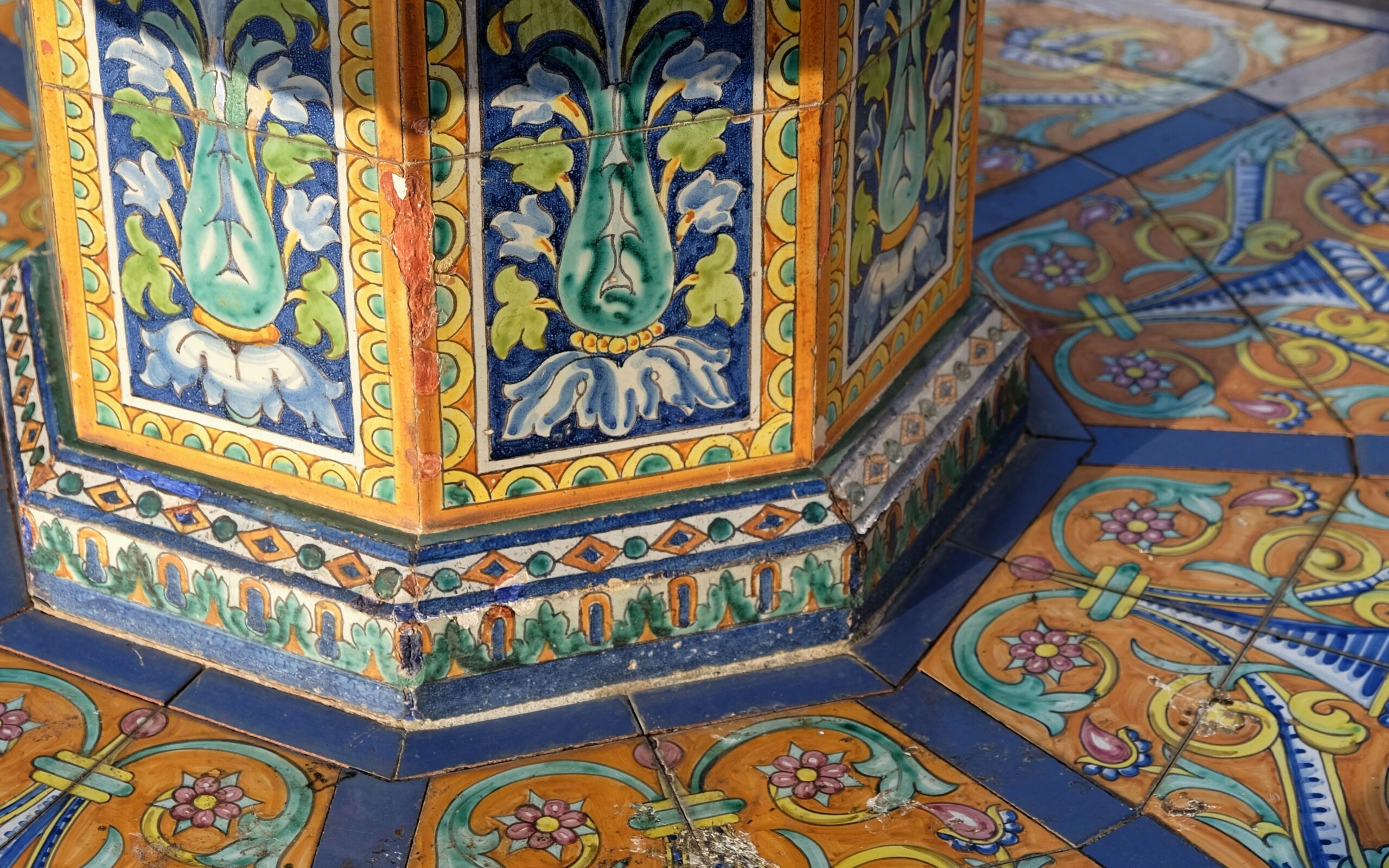Seville Itineraries
Top Attractions
- Royal Alcazar
- Seville Cathedral
- Metropol Parasol (Las Setas)
- Seville Bullring
- Plaza de Espana
- Casa de Pilatos
- Flamenco Show
- Maria Luisa Park
- Archivo de Indias
- Torre del Oro
- Seville Tiles (Azulejos)
- Bullfighting
- Football Stadium Tour
- Opera House
- Museum of Illusions
- Seville Aquarium
- Isla Mágica
- Jardines de Murillo
Disclaimer
Posts on visit-seville.com may contain affiliate links, meaning we get a small commission if you decide to make a purchase through our links, at no cost to you. Any income earned helps maintain this website and keeps it ad-free.
Seville Tiles – A History of Azulejos Sevilla
Discover the vibrant ceramic art that decorates Seville


Seville is famous for its colourful ceramic tiles, known as azulejos. This beautiful art form was introduced by the Moors and has become one of the city’s most recognisable features. You can spot these tiles almost everywhere, from grand palaces and churches to cosy patios and tapas bars.
In this page, we tell you everything about Seville’s tiles, their fascinating history, how they are made and the best places to admire them around the city.
History of Seville Tiles
Seville’s fascination with azulejos, the vibrant and intricately designed ceramic tiles, goes way back to the times when the Moors ruled southern Spain. Initially, these tiles were brought into Andalusia as an architectural element, featuring Islamic geometric designs. But over time, especially during the Reconquista when Christians took back control, the tiles underwent a transformation.
The word azulejo actually comes from the Arabic al-zellige, which means ‘polished stone’. The traditional use of azulejos was as flooring in grand palaces and religious buildings like mosques and later, churches. The Moors believed in the artistic representation of the mathematical and cosmic order, which is why you’ll see a lot of geometric patterns in these tiles.
When the Reconquista happened, the tiles began to show more figurative designs, including floral motifs, religious scenes, and even historical events. The Catholics integrated these Moorish designs into their own aesthetic, a style now referred to as Mudéjar.
As time went on, tile-making techniques continued to develop. During the Renaissance, artisans experimented with brighter colours and more detailed imagery, often inspired by Italian art. By the Baroque period, designs had become even more ornate, filled with decorative frames, mythological figures and vivid storytelling scenes. From the 16th century onwards, Seville’s Triana district became the heart of tile production, with workshops perfecting the craft and exporting tiles across Spain and beyond.
Over the centuries, azulejos became a symbol of the city itself. The Royal Alcazar is one of the best examples, with rooms covered in stunning patterns that reflect Seville’s rich blend of cultures. You can also see this art on a grand scale at Plaza de España, where each Spanish province is represented through beautifully detailed tilework.
Even today, tiles are part of everyday life in Seville and you’ll spot them in tapas bars, street signs, shop fronts and patios.
The Triana Ceramics Tradition
Just across the Guadalquivir River from the city centre, the neighbourhood of Triana has been the heart of Seville’s ceramics tradition for centuries. Its location was ideal for tile production, as they had easy access to clay from the riverbanks and convenient transport routes for sending tiles across Spain and other regions.
By the sixteenth century, Triana had become home to many of Seville’s most skilled artisans. Most of them worked in family workshops where techniques were carefully passed down from one generation to the next. The neighbourhood still has that creative energy today, and it remains one of the best places to see how azulejos are still made by hand.
We recommend visiting the Centro Cerámica Triana, a small but fascinating museum inside a former tile factory. It explains how Seville’s famous tiles were created over the centuries, showing original furnaces, tools and beautiful examples of historic designs. After visiting, it is lovely to wander through the nearby streets, where you will find shops selling handmade tiles and pottery.
Centro Cerámica Triana
Opening hours:
Tuesday to Saturday: 10:00AM to 8:00PM
Sunday: 10:00AM to 8:00PM
Closed on Monday
Entry price: 2 euros
Location: Calle Callao, 16, Triana, Seville.
Where to See Seville’s Tiles
One of the best things about Seville’s tiles is that you do not have to go far to find them. They are literally everywhere although some places truly stand out for their craftsmanship and history. Below are a few of our favourite spots to admire Seville’s most stunning tilework:
Royal Alcazar of Seville
The Alcazar of Seville is one of the best places to see the famous Sevillian tiles. The tiles here are like a timeline of styles, showing off the rich history of Seville, including who ruled the city, what they believed in and how they expressed themselves.
One of the most impressive spots is the Hall of Ambassadors (‘Salón de Embajadores’), decorated with mixed-style azulejos from the floor to the dome. Some of them show intricate Islamic designs, while others have Christian symbols like crosses and coats of arms.
Another beautiful place is the Courtyard of the Maidens (‘Patio de las Doncellas’), where you can see tiles that have been in place since the 14th century.
Plaza de España
If there is one place that truly represents azulejos in Seville, it is the Plaza de España. The curved walls of this grand square are covered with tiled benches that represent every province of Spain, each designed with its own colours and patterns. It’s a great place to take a break and appreciate the craftsmanship up close.
The plaza is surrounded by fountains, bridges, and ceramic railings, making it one of the most recognisable and photographed spots in Seville.
Casa de Pilatos
The Casa de Pilatos is often described as a smaller version of the Alcázar, and it is easy to see why. The combination of Gothic, Renaissance and Mudéjar styles gives the palace a unique charm, and its courtyards are filled with detailed tilework from different periods.
We would recommend visiting in the morning when the light makes the colours of the tiles stand out beautifully against the white walls and marble arches.
Palacio de las Dueñas
Another beautiful example of Sevillian tile art is the Palacio de las Dueñas, once home to the famous Duchess of Alba.
The palace is full of bright courtyards, elegant archways and colourful azulejos that reflect centuries of history. It feels peaceful and lived-in, giving you a sense of how tiles have always been part of everyday life in Seville’s grand homes.
How Azulejos are Made
The process of creating azulejos in Seville is an art that has hardly changed over the centuries:
- It all starts with clay, which is shaped into tiles and left to dry.
- Once dry, the tiles are fired in the kiln to make them firm.
- The surface is then covered with a white glaze, creating the base for decoration.
- Skilled artisans paint each tile by hand, using bright colours and traditional patterns.
- Finally, the tiles go through a second firing, which gives them their smooth finish, ready to decorate walls, courtyards and patios across Seville.
For those who want to experience it firsthand, you can take part in a ceramic tile workshop in Triana. It is a fun and creative way to learn the techniques and paint your own tile to take home as a souvenir.
Where to Buy Azulejos in Seville
If you fall in love with the Seville tiles and you want to bring a piece of that beauty home, there are several artisan shops where local craftsmen still paint and glaze each tile by hand. Most of them are found in Triana but you’ll also find lovely stores in the city centre. Check them all on the map below:
Azulejos Seville: Frequently Asked Questions
What does the word azulejo mean?
The word azulejo comes from the Arabic term al-zellige, which means ‘polished stone’. It reflects the Moorish influence on Spain’s early tile-making traditions. Over time, the word came to describe the colourful ceramic tiles that became so closely linked to Seville and its architecture.
Where can you see the best Seville tiles?
You can find some of the most impressive examples of azulejos in Seville at the Royal Alcázar, Plaza de España, Casa de Pilatos and the Palacio de las Dueñas.
More on Visit-Seville





